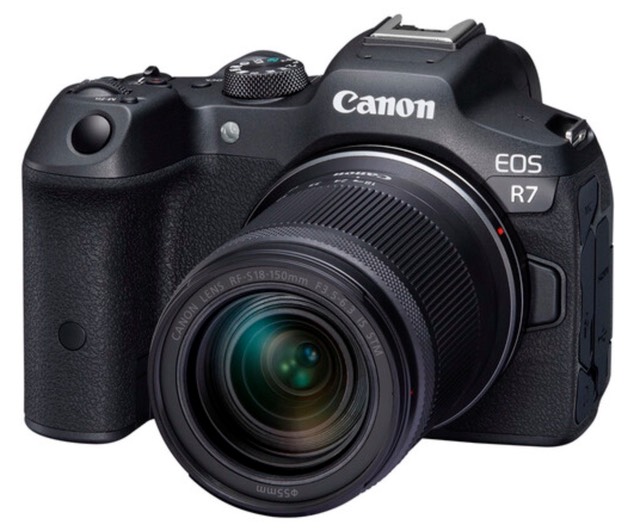
What is It?
The Canon R7 is now the top end of Canon's crop sensor mirrorless lineup, and it seems that the shift from M-mount to RF-mount I predicted has begun. I would characterize the M cameras as more PowerShot-like (consumer) designs, while the RF cameras are more DSLR-like (prosumer) designs. Whether Canon decides to keep the M crop-sensor line going in the future now seems in jeopardy, though Canon has for the time being kept the lower end DSLR-like R10 US$100 above the top end M6 Mark II.
Thus, you have to consider the Canon crop sensor lineup a bit like this now:
- M200 (US$550 with lens) — entry crop sensor mirrorless
- M50 Mark II (US$700 with lens) — low-end crop sensor mirrorless
- M6 Mark II (US$1100 with lens) — sophisticated rangefinder-like mirrorless
- R10 (US$979 body, US$1100 with lens) — low-end DSLR-type mirrorless
- R7 (US$1499 body, US$1899 with lens) — top-end DSLR-type mirrorless
In a different context, the R10 is like a recent Kiss/Rebel DSLR model (stripped of features, lower in performance) while the R7 is very much like a mirrorless 90D (higher end features, higher end performance), only enhanced in a number of new ways.
What most people want to know is whether the R7 actually performs more like a modern 7D type model (high frame rate, sports/birding capable). I'll answer that up front (without all the nuance): yes, it basically does, though you'll want to know all about the nuance (see Performance section, below). However, the R7 really does slot more against the 90D in my estimation. That's not a bad thing.
Let's start at the image sensor.
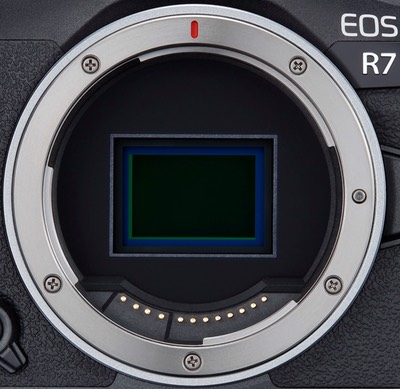
The R7 uses Canon's 33mp image sensor. As usual, we have the dual-pixel AF capability, and the R7 appears to use basically the same image sensor as the M6 Mark II. Given the deep detail specifics, I'm guessing that Canon has done a little tweaking of readout timing and perhaps a tweak to the filter laying over the sensor, but not a lot. The M6 Mark II had about a 1/25 readout timing (across about 90% of the frame), while the R7 appears to have 1/30 across all pixels. Unfortunately, that's still slow enough to cause considerable rolling shutter, and the 30 fps electronic shutter on the R7 definitely shows the impact of that.
33mp nets you 6960 x 4640 pixels, which is about a 17% linear resolution improvement over a 24mp sensor. That's just on the boundary of where most people would notice a difference in resolution. File sizes at the highest image quality settings tend to be about 11MB for JPEG, 35MB for raw (remember, all image files will vary in size due to differing amount of detail in the frame). The R7 supports HEIF (including RAW+HEIF) as well as C-RAW for those looking for better image quality but smaller file sizes.
ISO ranges from 100 to 32000, though a boosted 51200 is available. For some reason, the R7 has both Scene Intelligent Auto as well as special Scene exposure modes. The latter are a jumble of scenes and effects. E.g. Portrait is what I'd call a scene mode, where it alters aperture and a few other decisions, where Panorama is an effect mode, where the camera operates completely differently to normal. The latter, by the way, seemed really temperamental to me, as it was always complaining either that I was panning to slowly or too fast. Goldilocks speed seems like a pretty narrow band to me. There's also a Creative Filters mode. Canon's decisions here seem to be appealing to a different market than the high-end specs of the image sensor, shutter, and focus system.
Video capabilities are decent. The R7 can create 4K files at 24, 25, 30, 50, and 60 fps, and FullHD (1080P) at up to 120 fps. Both H.264 and H.265 can be created by the camera, with Linear PCM sound. IPB is used in the compression, and you also have support for Canon Log3 profiles, as well as BT709, BT2020, and Cinema gamuts. While I wouldn't put the video features at the same level as we find in the full frame bodies, this is Canon's most complete and capable set of video capabilities in their crop-sensor bodies. While not extreme, the video does have clear rolling shutter artifacts, which brings us back to still capabilities...
Because of the rolling electronic shutter, you're likely to choose the mechanical shutter on the R7 for action. At 15 fps, the frame rate of the mechanical shutter should be "fast enough" for most people. Unfortunately, the mechanical shutter is also loud for a mirrorless camera. Note that the manual is full of warnings about shutter type, some of which will throw you into conflict (e.g. "Defocused image areas may occur with EFCS" versus "Consider using EFCS to ensure effective image stabilization").
The mechanical shutter can be set from 30 second to 1/8000 second, while the electronic shutter extends the top end to 1/16000 second. Flash sync is 1/250.
Canon's specifications for the focus system are typical for Canon's dual pixel designs. Be careful, though in comparing low light focus ability across brands. Canon specifies -5EV for the R7, but that's with an f/1.2 lens. Video is less capable at -3.5EV, also with an f/1.2 lens.
The interesting thing about the R7's autofocus system is that it appears to be modeled on the R3's, with only a few things left off. You get subject tracking—has to be set specifically to subject (People, Animals, Vehicles)—and eye detection. Focus area can be set to spot, single area, expanded (two sizes), flexible zone (three sizes), or the entire sensor.
Out back you get a fully articulating Rear LCD that can fold back against the body for protection while traveling. That LCD is a typical TFT design with 1.62m dots across it's 3" size. Touch is supported throughout the interface.
The viewfinder is a 2.36m dot OLED, with an eyepoint of 22mm, and it includes diopter adjustment from -4 to +2. While the diopter adjustment isn't lockable, it is very stiff and resistant to being accidentally changed.
In terms of body build, the R7 is built on a metal frame, but the externals you'll interact with are all the usual Canon plastic. In terms of ruggedness, I don't find outer plastic to be any better or worse than metal. But I found the R7's plastic, even the part with the grippy bits applied, to be a little on the slippery side. Canon claims the same level of dust and water resistance as the 90D, by the way.
The overall size of the camera isn't quite what you might expect, as the R7 is barely different in size than the Sony A7 Mark IV also sitting on my desk at the moment. I'm sure some of that has to do with both the sensor-based IS platform, which takes up considerable space, as well as the articulating Rear LCD, which tends to also push the depth of a camera up from what it could be.
The R7 weighs 21.6 ounces (612g) with the battery and card loaded, which is three ounces more than the full frame Sony A7C. That said, for a high performance camera I like having a bit of bulk and weight, particularly when using telephoto lenses. It's a little easier to keep the camera steady if it isn't a featherweight.
The better comparison is against the 90D that the R7 essentially replaces. The 90D is significantly bigger in all three dimensions than the R7, though it's only 3 ounces heavier. The net result is that your camera bag isn't going to get lighter with an R7 in it, but you might be able to use a smaller bag.
While I'm writing about the body, the R7 has one aspect I applaud: the two camera strap connect points are almost lined up, which means that the camera hangs without a twist with a neck strap. Of course, I stopped using neck straps years ago, but still, it's a nice touch compared to some bodies where the engineers just put the hooks wherever they can find space and that results in the dreaded "twisted hang".
The R7 features two card slots loaded via a side door. The slots are matching with UHS-II support (yay!), Slot 1 is the first at the back of the camera (yay!), and cards go in with the labels facing you (yay! Take that, Sony).
Battery for the R7 is the LP-E6NH, same as the R5 and R6. The battery can be charged internally in the camera via USB when the camera is off, and you can power the camera via USB as long as battery is in the camera. This appears to be standard USB Power Delivery at the 15w, 3a level.
The five connectors on the left side of the camera (as you're holding it) have a nice door arrangement to them (four separate doors, so you don't have one big door hanging off the side of the camera just because you connected something. I found I have to open the HDMI door before flipping the Rear LCD, though. You get microphone, headphone, remote, USB, and HDMI connectors under four different doors. Unfortunately, the HDMI connector is the Micro (Type D), which is very difficult to keep plugged in under use.
Up in the hot shoe is a multi-function port at the front, which supports external microphones directly (e.g. Canon DM-E1D).
Wireless is a bit disappointing with only 2.4Ghz support, and GPS data either has to come from the mobile device or an external GPS receiver.
The R7 is made in Japan and retails for US$1499 (body only). Included with the camera are a body cap, LP-E6NH battery, LC-E6 battery charger, and camera strap.
Source of the reviewed camera: B&H loan
Canon's Web page for the camera
How's it Handle?
I suspect that regular Canon users will be okay with the R7, but even they probably will have some issues with Canon's design decisions, particularly the odd position of the rear command dial.
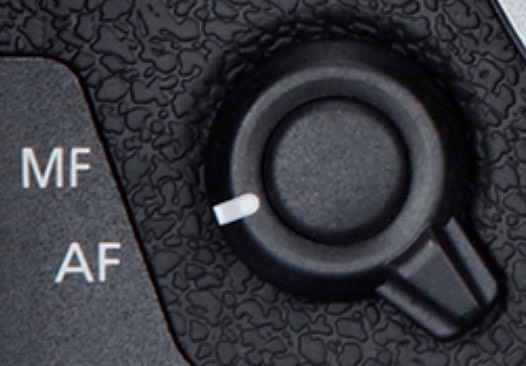
The first deviation of significance is right up front: there's a Nikon-style AF/MF switch with a DOF Preview button inside (button can be customized to other functions). On the opposite side of the mount from where a Fujifilm or Nikon user might expect it, too, so it isn't there to win over converts, it seems. There's a reason Nikon put it where you left thumb could reach it when cradling a lens. There appears to be no reason why Canon put their version where it is, as it doesn't naturally fall under any finger (unless, I suppose you have really big hands and they're falling off the front hand grip so much that you ring finger touches the control).
The next problem is the top controls.
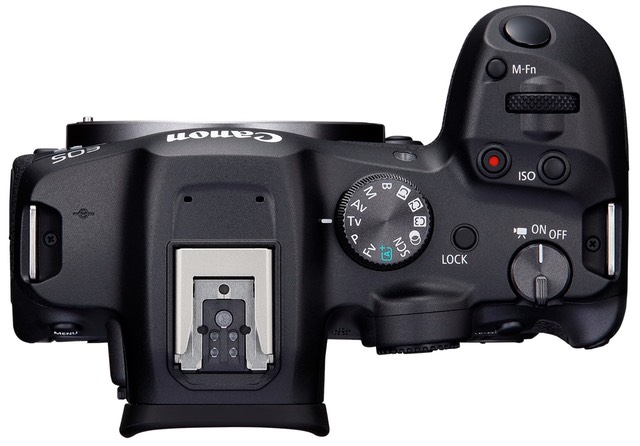
I'll preface my remarks about the top controls that I've never been a fan of Canon's "vertical" dial orientation and button clusters. They violate a rule I have, which is that I should never have to take my index finger off the shutter release when operating the camera via the viewfinder. Never. A missed moment is a missed moment. With action, I often interrupt changing a setting to press the shutter release for a peak moment.
Canon's vertical design and button clusters mean your finger is off the shutter release to use the top dial, the red button, the lock button, the M-Fn button, and the ISO button (on some older Canon cameras, it was worse). Part of the problem is that the shutter release is literally on the front of the hand grip, requiring you to push back into the camera to take a photo. You could, I suppose, use your middle finger on the shutter release to have one free to get to the controls I just mentioned ;~). Most would find that odd and the reach awkward.
So. Something I've long noticed about Canon ILC users will definitely be afoot with the R7: they're going to take their finger off the shutter release to control something. And historically, I've noticed that a lot of Canon users also take the camera completely down from their eye when using these top controls (often because they're not distinguishable by feel).
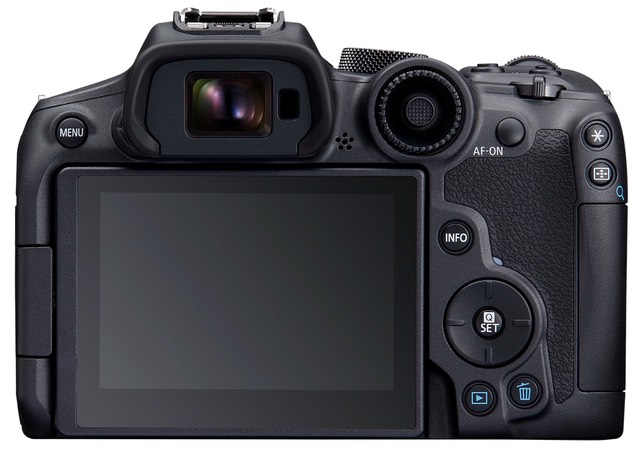
Next up we have the * and zoom buttons stacked vertically on the right back instead of horizontally. The R6/R5 have them horizontally, the R7 has them vertical. But the big—and I mean literally big—change on the camera backside is the thumb stick, which now gets a bulge that sticks off the top of the camera and a dial around the actual thumb stick. It seems clear that Canon wants you to use this control, since it's so big. But that makes the AF-ON button to its right tiny, barely sticking out, and indistinguishable if you have gloves on.
If you've used an R5 or R6, the R7's controls just seem a little resized and tweaked in position by comparison, so perhaps we're now seeing the new Canon UX (no more R bar). If so, I don't particularly like it, though I can adjust to it. Many of the complaints I made in my R6 review are being repeated here. Despite the R7 being a reasonably small camera and the fact I don't have big hands, there's just something that feels a bit awkward in both my hand and finger positioning. It's not uncomfortable, but it takes some getting used to.
Fortunately, there's some good news in the handling department. The articulating Rear LCD is my preference (compared to tilting). However, the HDMI/USB connector placement is dead in front of the screen when the screen's folded forward, and if you look carefully, you'll see that this must have created an unwanted design issue, because the forward position of the Rear LCD doesn't actually quite reach parallel with the image sensor: you're looking at the Rear LCD at a slight angle when holding the camera from the front.
Moreover, if you're going to use the R7 for Selfie/Vlogging, I find it awkward to hold and control it. Your index finger isn't going to be on the shutter release (for selfies), and your fingers are going to be stretching to make any control change while vlogging. The R7 does have the multi-function hot shoe that allows you to put a better microphone up top without cables, though, so at least you can have a decent mic pointed at you without having a cable running in front of the Rear LCD while vlogging.
Much of the above I consider rookie mistakes, and mistakes I don't expect to see in a US$1500 camera.
Oddly, the INFO button can lead you to a screen with info, but instead of direct touch capability on that screen, you have to use the Q (quick) button, which moves from top right to bottom left on this particular screen. I can see the reasoning behind the "no touch" decision on the info screen (you won't accidentally reset camera if you've left it on that screen), but I don't understand why you'd move the location of the on-screen Q button. It's little things like that that slow me down a bit when trying to use all the features of a camera. Fortunately, the center button on the Direction pad also substitutes as a Q button, so I'd suggest you just default to using that, as it doesn't move ;~).
Another oddity is the Lock button (which is not configurable). It simply locks the dials. In effect, this turns into an aperture/shutter speed/exposure compensation lock (depends a bit on what the dials are assigned to and what exposure mode you're in). Okay, nice, I like that. But it's in a place (again) where I have to move my finger positions off the shutter release. (Sensing a theme?) I've also touched it accidentally a couple of times, too.
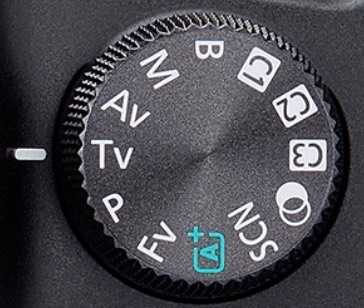
Perhaps giving away Canon's intentions a bit: the R7 includes Intelligent Auto, Scene, and Creative Effects exposure modes. These include a fair amount of user handholding, fortunately including some dismiss-in-the-future guidance boxes. These functions feel a bit out of place on a US$1500 camera with such high performance capability. But it shows that Canon wants to sell this camera to someone who might grow into those performance capabilities over time. Unfortunately, they also clutter up the Mode dial, though I do like the B (bulb) setting on the Mode dial. I'm less enthused by the addition of Fv, which is essentially a mode choice within a mode dial. As noted in the manual, you get four choices with Fv, which are "similar to", yep, you guessed it: PASM (or in Canon parlance, P, Av, Tv, and M).
All of the above isn't helped by the fact that you don't get a full manual with the R7 in the box. I strongly suggest that everyone buying this camera get the full PDF file and put it on their tablet. That PDF file runs 963 pages, is searchable, and has very good cross referencing links. You're going to need that manual to come to full grips with the more advanced abilities of the camera.
While, as usual, I've found a lot of nits to the handling of a camera I'm reviewing, I do this more to warn you about all the small things that can trip you up just enough to miss a photo opportunity. On a camera that has high frame rate performance and fast focusing such as the R7, you really need to come to grips with the handling in order to extract everything the camera is capable of.
I expected a bit more from the handling side of the R7. While it's deep and broad in its capabilities, it doesn't feel refined. I kept bumping up against things I'd call "rough edges", something I generally don't expect in a US$1500 camera. That said, I adjusted to those edges and dialed the camera into the way I wanted to use it (hint: it's not exactly the way Canon has configured it ;~).
To me, the biggest fault of the Canon UX is this: if I want to change aperture, my finger comes off the shutter release.
So I guess the good news is this: there's enough customization capability on the R7 to "tune" it to your needs. Still, it feels like some potential was missed in the design that is the default, and that in some places Canon tried to hedge their bets by adding entry-camera features. More so than most cameras I've reviewed in the last five years, the R7 feels more like a camera designed by committee than others.
How's it Perform?
Battery: The CIPA numbers create more paranoia than is warranted. 660 images CIPA sounds limiting, particularly when compared to older DSLRs. I'll point out that the CIPA tests these days actually tend to be more of a measurement of hours of battery life, not images.
Why? Because the basic test involved to create that number keeps the camera fully powered during the test with 30-second intervals between taken images. Thus, from the CIPA numbers I'd expect the R7 to stay powered for about 5.5 hours. During that time, taking images doesn't particularly drain the battery all that much. I've already read where some early R7 users were getting thousands of images per battery charge, and I'll just say that my first sessions were well over 1000 images each, and I was trying out all kinds of things that might have had a battery impact.
Buffer: Let's just state up front that 30 fps at 33mp is unique in the APS-C sensor world as I write this. That's a lot of information being generated in a lower cost camera, so some compromises do come into play. Canon claims a max of 184 JPEG and 46 RAW files at the highest settings with the mechanical shutter (though with One Shot AF). I found that somewhat optimistic using a ProGrade UHS-II card. I consistently got more like 32 RAW frames with IS, AF, exposure, and a few other features I would suspect you'll want to use all active. That's a little constraining (two seconds), but I'm not the type to just mash the shutter release forever. What I found more problematic was that the R7 dropped way down in fps once the buffer filled (<2 fps), and the buffer clear time was over 10 seconds.
Using C-RAW puts the buffer closer to 100 frames with my usual settings. With some setting changes and an even higher end card with better sustained write speeds, I could coax that a bit higher. JPEG and HEIF aren't a problem; worst case I found there was seven seconds of buffer, which really ought to be adequate for just about anything you'd want to record.
One curious feature that can net you more images per burst is to enable Raw Burst Mode. This puts all the raw information into a single file from which you can extract the frames you want. Using this feature the buffer will be larger, but then you have the workflow problem of getting the frames you want separated out.
Another curiosity is the Pre-Shot capture feature, which on the R7 works differently than on a number of other cameras, in that the pre-shot capture is a separate, different file that has to be addressed through workflow (much like the Raw Burst Mode feature). At the moment, only Canon's DPP allows you to extract the individual files externally, but the camera can do it the same as Raw Burst Mode. This, coupled with the not-enormous buffer, makes the Pre-Shot capture less useful to me than I'd like.
Personally, I don't have any real issues with the R7's buffer for my style of photography. The primary thing I had to be careful of was repeating a burst too quickly (before the buffer was fully written to card). Shutter release mashers expecting the camera to respond forever may be disappointed, however, depending upon their card choice and settings. The clear thing to note, however, is that the better the card you put in the camera, the better the buffer will be. Don't think of putting a UHS-I or even older card in the R7 and getting any decent buffer performance. At a minimum, you need UHS-II, and look closely at the video rating on the card: the higher the number, the better the sustained write performance will be, even for stills.
Miscellany: I was struck by both the warning in the manual and the sticker behind the Rear LCD, both of which warn about the camera getting hot to the touch. Running the camera to fill a 64GB card, the temperature on the back panel of the camera rose from 75°F to 92°F in my controlled test. Obviously, your mileage will vary, but a full card of continuous photography did raise the temperature nearly 20°F in a controlled temperature room, so the camera does throw off heat in repeated, continuous use. In an ambient environment of nearly 100°F, the camera actually produced a higher degree of heating, quickly reaching 120°F on the back panel.
However, I didn't find this particularly different than virtually any other high performance digital camera out there. Some, like my Nikon Z9, do a bit better at dissipating heat. Some, like the R5 I previously tested, do a little worse. My suggestion is the same as with most cameras: simply pay some attention to what the camera is doing in intense heat environs, and to shade it when possible, as well as letting it cool between shorter constant use.
In the month I had with the R7 before I had to return it, I concentrated on still photography, so I didn't do much in the way of video work other than to confirm abilities and settings capabilities. I was able to record video at up to battery exhaustion without overheating at the highest in-camera recording levels. Basically, a bit over an hour. However, I could not get a full second hour recorded immediately with a fresh battery inserted because the camera soon overheated enough to shut down. However, this, too, is basically normal with most current state-of-the-art cameras.
Another miscellaneous finding: full mechanical shutter absolutely has shutter shock in the sub 1/250 second range. The worst seems to happen at 1/125 second. You should be using Electronic First Curtain Shutter on the R7. Let me put that into context:
- Mechanical — shutter shock at lower shutter speeds
- Electronic First Curtain — fine
- Electronic — rolling shutter artifacts on motion
Unfortunately, the 30 fps electronic shutter speed has considerable rolling shutter issues, particularly with the subject that many will most want to use it with: birds in flight. While you don't tend to see the rolling shutter impact on head and body, it is a real issue with wingtips. In a 60 image sequence of a BIF moving at any speed, especially larger birds, you'll see that the outer wings keep changing shape and acuity with virtually every image. Depending upon the bird and how it uses its tips, things can look really wonky. This isn't an issue with mechanical shutter.
Viewfinder blackout was basically not present, though there's a bit of jitter to it when panning in Mechanical modes, and the all-electronic mode feels a little too "pulse-y" when panning (the white border bar flashing doesn't help).
Focus: Snappier than I expected. There's much talk that the R7 gets the R3 focus system with a few omissions, and I'd say from my experience with the camera, that seems basically true.

Interestingly, the R7 still thought this was a bird and focus was locked on the head. Maybe if I had tried Portrait mode... ;~)
Focus performance is tough to describe decently, though, as you're going to have some variability in it up to the point where you learn and master it. Yes, the R7 models the R3 autofocus system, which is a good thing, as the R3 is currently Canon's best. That said, I did find some things that gave me a bit of pause.
I'll get right to it: variable light conditions can make for variable autofocus performance.
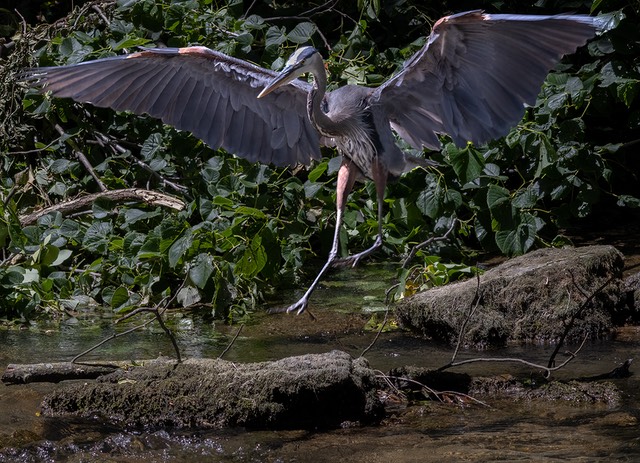
Frank Jr., my local resident heron likes to sit in an area that's very difficult when it comes to autofocus. He's in and out of filtered sun, basically (see the difference on his legs). In the short flight you see a sample of above, Frankie went from deep shade, through mottled light, into the sunlight, and then into a combination of sunlight and shade. The R7 struggled a bit in figuring out where to put the focus cursor as a result. In the image above, it's on the body of the heron, not the head/eye. Not a terrible result, but one that I found happened more often in tough light than I'd like.

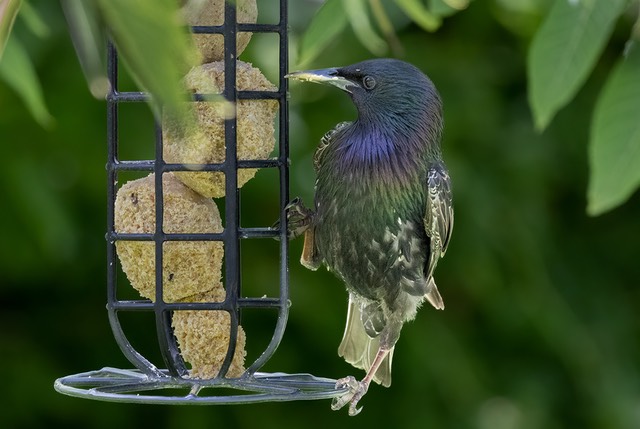
In fixed light conditions, whether completely sunlight or completely shade, the R7 had no real problems. It found and locked onto dogs, birds, rabbits, deer, and my back yard groundhog just fine. As you can tell from the canine image, above, the camera doesn't have an issue with finding the eye on side portraits, either.
Most users are going to find the autofocus performance fine, as it's somewhat rare that you'd be in the mixed light conditions that I get in several places along the Little Lehigh. I even pressed the camera by using f/8 and f/11 maximum aperture lenses at times, and still didn't really have issues with focus performance in unchanging light.
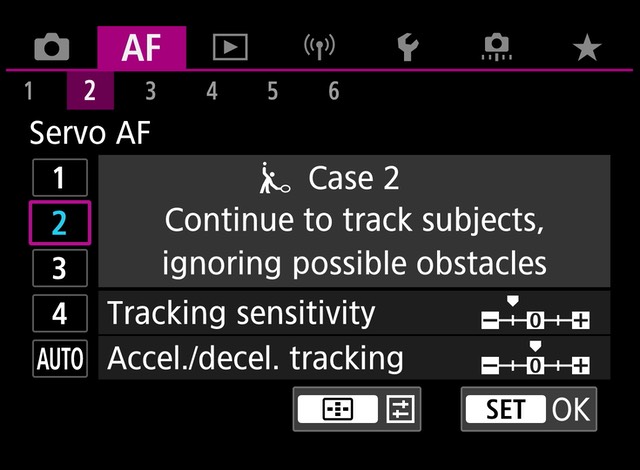
I'll warn you in advance that to extract everything the focus system is capable of you're going to have to a bit of study. Canon's full Servo AF page (AF, page 2, above) is something you'll need to understand and set correctly for the subjects you're working with. I also wish there a little more flexibility in what can be assigned to each of the buttons, but there is a Switch to Registered AF Func capability that you're going to want to explore. I set my R7 so that I could quickly switch to a preferred set of AF functions via a button press for certain situations. However, my complaint on the R7 is similar to a complaint I've had at times with Nikon: I don't want Canon restricting the things I can set each button to, I want the full set of options for every customizable button, something that Sony does consistently now.
The paternal "we'll let the user only do this with that" design almost never provides me an option that I'd want to set, and I found that with several of the buttons on the R7.
In terms of focus speed, even on the small aperture, inexpensive lenses I found the R7 to be pretty snappy in focus. Much of the time I was using an f/8 maximum aperture in shade, but I didn't find that to cause focus issues. That makes those inexpensive f/11 telephoto lenses more interesting, though on an APS-C sensor you're going to be more restricted to Sunny 16 in using them. (Why? Sunny 16 says 1/ISO is the shutter speed at f/16. So, in bright light, f/11 means 1/200 at ISO 100. With birds in flight and many sports, I want to be at 1/2000. So I'm already at ISO 1000+ in bright light. Any drop in lighting starts getting me into high ISO ranges on an APS-C sensor camera at f/11.)
Image Quality: Before I get specifically into image quality I do have to say something about Canon's Evaluative Metering Mode. It's simply not as good as Nikon's matrix metering (best in class), or even Sony's (solid second place). You see this specifically when panning around an area where the light level is not changing. Canon cameras make much more of any brightness changes within the frame than do the competitors, even when the light is not changing.
So I'll say this: if you really want to extract everything out of the R7 image quality you can, you need to be paying a lot of attention to what the metering is doing. Running "all auto" is not optimal. Personally, I meter the light, and set the camera in manual exposure mode for the light (with some attention to highlight placement, or expose to the right [ETTR]). Thus, my comments below are based upon what I controlled, not what the camera did with a bunch of automatic settings enabled.
I no longer have a 90D to compare to, but my initial impression—verified by looking at other's results—was that the R7 images look better out of camera, with more contrast and perhaps a little more acuity. Noise looks a little more "roughed up" on the R7 at high ISO, but not at the expense of edge acuity, so I'm not sure what Canon did there. Perhaps it's the result of a change in the filter layer in front of the sensor, something Canon has been playing with in terms of anti-aliasing response. If I had to characterize it, the roughing appears to have a long axis component to it. Before everyone gets riled up: you really have to pixel peep carefully to see the difference, but it clearly seems to be there.
As for basic ISO performance, I'd say this: out of camera JPEGs are fine through ISO 3200 with minimal noise reduction. ISO 3200 is where I start seeing chroma noise, particularly in any underexposure of raw files (or deep shadows). That said, ISO 6400 is still very usable, and ISO 12800 marginally so. It's ISO 25600 where everything starts to blow up in raw files to the point where I want to avoid that value if at all possible.
But let's also talk about resolution, since the R7 is now currently the highest megapixel count APS-C camera available. Does 33mp "resolve more" than 24mp?
The answer to that gets a little complicated, and is even more complicated by some of the RF lenses Canon is pushing. First, the R7 has a low pass filter, which anti-aliases detail below the Nyquist frequency. Canon doesn't seem to make claims about using their newer low pass filter technology on the R7 (as they did on some of the full frame cameras, for example), but I'd tend to say that the "blur" from the low pass filter is very minimal. Technically, on llpm testing, with a top level lens the R7 comes fairly close to the R5 in terms of peak capability. What you have to watch out for, though, is diffraction.
Diffraction starts to get "well recorded" at f/8 on the R7. Apertures that slow or even slower show noticeable drop off in llpm testing. Which brings me to a comment: Canon's pushing a lot of slow aperture lenses these days in RF, particularly in the telephoto range. f/8 and f/11 is common in many of the lenses that an R7 user might be considering, because of price. I'm going to simply say that "yes, you'll see a clear difference in resolution between using the 600mm f/4L and the 600mm f/11 DO on the R7. A very clear difference.
Which brings me to this: the proper telephoto zoom on the R7 probably is the 100-500mm f/4-7.1L, not the 100-400mm f/5.6-8, at least if you're looking for best feather/fur/texture resolution. Of course, there's a 2x difference in weight and 4x difference in price. But that brings up a key question in terms of image quality: are you pursuing "good enough at a modest price" or do you want "best possible without breaking the bank"? Canon's giving you the choice to go either way, basically, but my own personal preference is to put a faster, better telephoto lens on this camera in order to extract everything it is capable of, which is quite a bit.
Final Words
I found myself in a bit of a love/hate relationship with the Canon R7. I think I like more on the inside than the outside ;~).
Inside we get one of the best-to-date APS-C image sensors and the DIGIC X-driven dual-pixel focus system coupled with a fast 15 fps mechanical shutter and a decent EVF. All really good news. Outside the camera felt slightly awkward to me, and in a way that the R6 didn't, even though they share so much in the way of controls and design.
Thinking way back to the Canon 7D Mark II DSLR, I remember having somewhat the same reaction when I picked it up after the 1DX I was using. Canon's doing something a bit different in development for the APS-C world when compared to their full frame offerings. I'm pretty sure the Canon APS-C body designs aren't being vetted the same way the full frame ones are, and that shows up in subtle ways that are tough to describe. Yes, the R7 can be picked up and used by someone not particularly familiar with managing a dedicated camera (A+ and Scene modes). But providing options like those added both complexity and simplification to the overall design at the same time, and that muddies the waters over who Canon really wants to buy the camera.
That said, I have to get to function and substance to express a useful opinion, as handling can be something everyone evaluates differently. So...
Function is quite good on the R7. Substance is also very good on the R7. If you're looking for a high-end APS-C mirrorless body, Canon's put out a camera you need to take a look at. What I found once I configured it and ignored all the hand-holding and control placement bits that I found awkward was a highly competent camera that should intrigue anyone looking for sophisticated abilities in a non-full-frame price.
With the right lens, yes, the R7 can be a reasonable birding and sports camera. In point of fact, I prefer it to the current higher end Fujifilm (X-T4) and Sony (A6600) APS-C offerings, as the Canon R7 operates much more like a DSLR, handles more like a DSLR, and in the case of the Fujifilm X-T4, the R7 focuses faster, more accurately, and with better intelligence. The 33mp files from the R7 also look as good as APS-C gets.
Current Canon DSLR/RF users won't have as much frustration with the R7 as you may think I had (from reading all the above nits). To a large degree, Canon hasn't messed too much with Canon mainline UX (though the dial around the thumbstick is a little odd and will take some getting used to). Canon M users might find the R7 a bit different than they're used to, though M6 Mark II users will recognize the image quality as being consistent with their experience.
Those coming from other brands and mounts may find the R7 a little more troublesome to learn, particularly Nikon users, as the Canon UX is different and there's just enough subtle shading with the R7 that you'll find yourself quickly looking in the manual for help. But I came to grips with the R7 (somewhat literally), and so will you if you give it time and a full workout.
Which brings me to this: is the R7 a Nikon D500 replacement? The D500 has for five years been what I refer to as the best all-around APS-C (DX) camera you can buy, and coupled with Nikon's svelte PF lenses, the reigning BIF/action camera, too. Five years is like dog years in digital: it feels like forever.
Well, forever is beginning to end. Canon RF has numerous svelte-but-slow-aperture lenses, and the R7 certainly has some performance capabilities that exceed the D500 (and many that almost-but-not-quite match it). If Nikon wants to keep selling mid-to-high end DX cameras, they'll have no choice but to make a Z model that takes on the R7. The R7 isn't a D500 killer, but it's definitely put that Nikon body on life support.
Next I come to price. Initially I was a bit on the fence about this. US$1500 is near the top of recent APS-C pricing (the X-T4 is US$1800, the A6600 is US$1400, the D500 is US$1600 as I write this). But given what I wrote above about the other APS-C models, Canon is actually being competitive here: aggressive function and performance while being at the low end of the high pricing.
My initial pricing hesitance mostly had to do with full frame models. Now that no one is discounting their current full frame models significantly, there's some clear price room between the R7 and any full frame option that might attract that same customer, such as the Sony A7 Mark IV or Canon R6. A US$1000 differential is enough to add a significant lens, and if you're just moving to mirrorless, you're going to want to add a significant lens, I'm pretty sure.
Of course: what lens would that be for the R7? The 18-150mm kit lens adds US$400 to the price. There isn't a significant lens that truly makes use of the US$1000 gap (buzz, buzz*). Hmm, let's go to the database...hello? Anything there?
Here's what I finally concluded were two current RF lenses I'd want for the R7 if I were using the R7 as my general, all purpose camera: the 14-35mm f/4 (US$1700) coupled with the 24-105mm f/4 (US$1100). Sure, the 100-400mm f/5.6-8 (US$700) and 600mm f/11 DO (US$700) look like something I'd want to try for telephoto despite the constrained apertures, but where's the beef when it comes to all-purpose? The available kit lenses aren't wide enough (essentially 29mm effective at the wide end), and I'd need a wide angle zoom to complement them (only two available, and both not inexpensive).
So my final recommendation comes down to this: conditional. Are the right lenses available for you? If so, then I can definitely recommend the R7. If not, you need to look elsewhere or hound the Canon execs until they give you what you want (buzz, buzz*).
Recommended (conditional) (2022 to present)
Support this site by purchasing from the following advertiser:
*What the heck is that "buzz, buzz" thing all about? That's a shorthand I had to develop for my on-going complaint when Nikon stopped making useful DX lenses for their crop-sensor DSLRs. In essence, I wanted Nikon execs to feel like a gnat or fly was constantly in their face every time DX lens choice was mentioned until they addressed the issue. They didn't address the issue, so I probably wrote buzz, buzz in my commentary and reviews more than a thousand times in the past decade.
I'll state it again: if you want to really play in crop-sensor, you need to support it with lenses. OMDS and Panasonic have a very full line of lenses available. Fujifilm has a full line of lenses available, at least up to the point where we hit significant telephoto lengths, though they seem to understand they need more of those (their most recent XF mount lens announcement is a significant telephoto that was previously missing). Sony has an improving line of crop-sensor lenses available, though they do tend to be more video/vlogging/casual focused. Canon? Two kit lenses. Maybe a couple of M-transfers are coming, but I've long held that the M cameras were also held back by their lack of a full lens set. So buzz, buzz Canon execs. I'll be flying around you for awhile, it seems...
